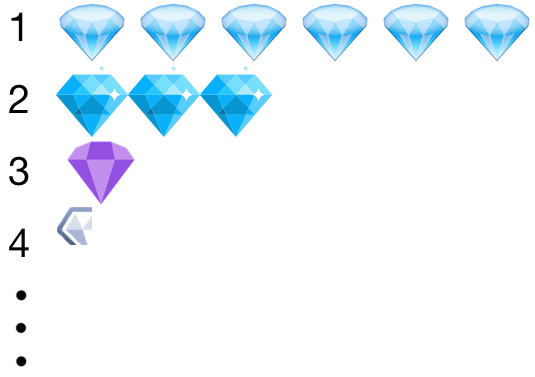Rare Gems

On a distant planet, there are many types of gemstones, numbered according to rarity:
The second gemstone is twice as rare as the first gemstone,
the third gemstone is thrice as rare as the second,
the fourth gemstone is four times as rare as the third, and so on.
That is, the nth gemstone is n times as rare as the (n - 1)th.
There are an infinite number of these gemstones. What proportion of gems are the first type, rounded to the nearest thousandth?
The answer is 0.582.
This section requires Javascript.
You are seeing this because something didn't load right. We suggest you, (a) try
refreshing the page, (b) enabling javascript if it is disabled on your browser and,
finally, (c)
loading the
non-javascript version of this page
. We're sorry about the hassle.
Let the proportion of the 1 st gemstone be k , then
the proportion of the 2 nd gemstone is 2 1 × k = 2 ! k ,
the proportion of the 3 rd gemstone is 3 1 × 2 ! k = 3 ! k ,
the proportion of the 4 th gemstone is 4 1 × 3 ! k = 4 ! k ,
and so on.
This suggests that the proportion of the n th gemstone is n ! k , where n is a positive integer.
Let us prove the claim above by induction :
Basic step : n = 1 is true because the proportion of the 1 st gemstone is k = 1 ! k .
Inductive step : Assume n = m is true for some positive integer m , then the proportion of the m th gemstone must be m ! k . Extending this shows that the ( m + 1 ) th gemstone must be m + 1 1 × m ! k = ( m + 1 ) ! k . So the proposition for n = m + 1 is true as well. Thus our claim is indeed true.
Now let's calculate the proportion of the first gemstone (as compared to the entire population of gemstones):
total proportion of all the gemstones proportion of the first gemstnone = = = = = 1 ! k + 2 ! k + 3 ! k + 4 ! k + ⋯ k 1 ! k + 2 ! k + 3 ! k + 4 ! k + ⋯ k 1 ! 1 + 2 ! 1 + 3 ! 1 + 4 ! 1 + ⋯ 1 − 0 ! 1 + ( 0 ! 1 + 1 ! 1 + 2 ! 1 + 3 ! 1 + 4 ! 1 + ⋯ ) 1 − 0 ! 1 + e 1 1 = e − 1 1 ≈ 0 . 5 8 2
Note that the series of e x can be expressed as r = 0 ∑ ∞ r ! x r , so e 1 = 0 ! 1 + 1 ! 1 + 2 ! 1 + 3 ! 1 + 4 ! 1 + ⋯ .